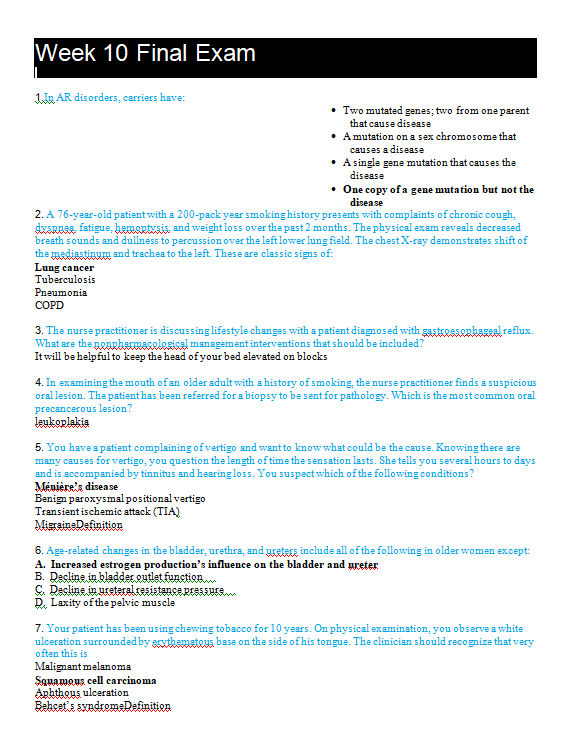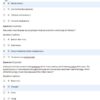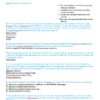Description
NSG 6420 Final Exam Week 10 – Question and Answers
- 1.In AR disorders, carriers have:
- A 76-year-old patient with a 200-pack year smoking history presents with complaints of chronic cough, dyspnea, fatigue, hemoptysis, and weight loss over the past 2 months. The physical exam reveals decreased breath sounds and dullness to percussion over the left lower lung field. The chest X-ray demonstrates shift of the mediastinum and trachea to the left. These are classic signs of:
- The nurse practitioner is discussing lifestyle changes with a patient diagnosed with gastroesophageal reflux. What are the nonpharmacological management interventions that should be included?
- In examining the mouth of an older adult with a history of smoking, the nurse practitioner finds a suspicious oral lesion. The patient has been referred for a biopsy to be sent for pathology. Which is the most common oral precancerous lesion?
- You have a patient complaining of vertigo and want to know what could be the cause. Knowing there are many causes for vertigo, you question the length of time the sensation lasts. She tells you several hours to days and is accompanied by tinnitus and hearing loss. You suspect which of the following conditions?
- Age-related changes in the bladder, urethra, and ureters include all of the following in older women except:
- Your patient has been using chewing tobacco for 10 years. On physical examination, you observe a white ulceration surrounded by erythematous base on the side of his tongue. The clinician should recognize that very often this is
- When interpreting laboratory data, you would expect to see the following in a patient with Anemia of Chronic Disease (ACD)
- What test is used to confirm the diagnosis of appendicitis?
- Functional abilities are best assessed by:
- Your patient is a 43-year-old female golfer who complains of arm pain. On physical examination, there is point tenderness on the elbow and pain when the patient is asked to flex the wrist against the clinician’s resistance. These are typical signs of:
- An 86-year-old patient who wears a hearing aid complains of poor hearing in the affected ear. In addition to possible hearing aid malfunction, this condition is often due to
- Which lesions are typically located along the distribution of dermatome?
- n differentiating a gastric ulcer from a duodenal ulcer, you know that each type of ulcer can present with distinct signs and symptoms. Which of the following pieces of information from the patient’s history is the least useful for you to determine that the patient has a duodenal ulcer?
- A pneumatic otoscopic examination is used to assess:
- In autosomal recessive (AR) disorders, individuals need:
- Which of the following disorders can cause urinary incontinence?
- An older patient reports burning pain after ingestion of many foods and large meals. What assessment would assist the nurse practitioner in making a diagnosis of GERD?
- Which of the following medications are commonly associated with the side effect of cough
- A 55-year-old post-menopausal woman with a history of hypertension complains of jaw pain on heavy exertion. There were no complaints of chest pain. Her ECG indicates normal sinus rhythm without ST segment abnormalities. Your plan may include
- Your 24-year-old female patient complains of dysuria as well as frequency and urgency of urination that develops the day after she uses her diaphragm. Urine culture reveals a bacterial count of 100 CFU/mL. These signs and symptoms indicate
- Epistaxis can be a symptom of:
- A careful history of a female client with a chief complaint of intermittent diarrhea reveals that she also experiences bouts of constipation. She has no known allergies and experienced no unintentional weight loss. What is the most likely condition
- When assessing an elderly client who reports a tremor, which assessment findings would be most reliable in identifying Parkinson’s disease?
- Which of the following best describes the pain associated with osteoarthritis?
- During physical examination of a patient, you note resonance on percussion in the upper lung fields. This is consistent with:
- Jeff, 48 years old, presents to the clinic complaining of fleeting chest pain, fatigue, palpitations, lightheadedness, and shortness of breath. The pain comes and goes and is not associated with activity or exertion. Food does not exacerbate or relieve the pain. The pain is usually located under the left nipple. Jeff is concerned because his father has cardiac disease and underwent a CABG at age 65. The ANP examines Jeff and hears a mid-systolic click at the 4th ICS mid-clavicular area. The ANP knows that this is a hallmark sign of:
- During auscultation of the chest, your exam reveals a loud grating sound at the lower anterolateral lung fields, at full inspiration and early expiration. This finding is consistent with:
- Your patient complains of a feeling of heaviness in the lower legs daily. You note varicosities, edema, and dusky color of both ankles and feet. Which of the following is the most likely cause for these symptoms?
- Which of the following details are NOT considered while staging asthma?
- Mr. A presents to your office complaining of chest pain, mid-sternal and radiating to his back. He was mowing his lawn. He reports the pain lasting for about 8 minutes and went away after sitting down. What is his most likely diagnosis based on his presenting symptoms
- A 22-year-old female patient complains of excessive thirst, feeling “shaky when she misses meals” and increased frequency of urination. Family history is positive for cardiovascular disease, cerebrovascular disease, and diabetes. The patient denies use of tobacco, alcohol, or other drugs. She takes no medication. Daily diet is fast food, and the patient does not exercise regularly. On physical examination, there are no significant findings except obesity, demonstrated by a BMI of 35 and blood pressure of 145/ 90. The signs and symptoms are characteristic of:
- Your 66-year-old male patient has recently started treatment for metabolic syndrome and is currently taking the following medications: an ACE inhibitor and beta blocker for treatment of hypertension. He is also taking a statin medication, simvastatin for hyperlipidemia, and a biguanide, metformin, for type 2 diabetes. The patient complains of myalgias of the legs bilaterally and blood work shows elevated serum creatine kinase. Which of the medications can cause such a side effect?
- Helicobacter pylori is implicated as a causative agent in the development of duodenal or gastric ulcers. What teaching should the nurse practitioner plan for a patient who has a positive Helicobacter pylori test?
- Which of the following is the most important question to ask during cardiovascular health history?
- Dan G., a 65-year-old man, presents to your primary care office for the evaluation of chest pain and left-sided shoulder pain. Pain begins after strenuous activity, including walking. Pain is characterized as dull, aching; 8/10 during activity, otherwise 0/10. Began a few months ago, intermittent, aggravated by exercise, and relieved by rest. Has occasional nausea. Pain is retrosternal, radiating to left shoulder, definitely affects quality of life by limiting activity. Pain is worse today; did not go away after he stopped walking. BP 120/80. Pulse 72 and regular. Normal heart sounds, S1 and S2, no murmurs. Which of the following differential diagnoses would be most likely
- The most common neurological cause of seizures in an older adult is
- A 70-year-old white male comes to the clinic with a slightly raised, scaly, pink, and irregular lesion on his scalp. He is a farmer and works outside all day. You suspect actinic keratosis, but cannot rule out other lesions. What recommendation would you give him?
- A 59-year-old patient with history of alcohol abuse comes to your office because of ‘throwing up blood”. On physical examination, you note ascites and caput medusa. A likely cause for the hematemesis is:
- A 66-year-old patient presents to the clinic complaining of dyspnea and wheezing. The patient reports a smoking history of 2 packs of cigarettes per day since age 16. This would be recorded in the chart as:
- Which of the following conditions is the most common cause of nausea, vomiting, and diarrhea
- The nurse practitioner orders bilateral wrist X-rays on a 69-year-old gentleman complaining of pain in both wrists for the past 6 weeks not related to any known trauma. The nurse practitioner suspects elderly onset rheumatoid arthritis. The initial radiographic finding in a patient with elderly onset rheumatoid arthritis would be:
- Rheumatic heart disease is a complication that can arise from which type of infection?
- A 23-year-old patient who has had bronchiectasis since childhood is likely to have which ofthe following:
- Iron Deficiency Anemia (IDA) is classified as a microcytic, hypochromic anemia. This classification refers to which of the following laboratory data?
- An 82-year-old female presents to the emergency department with epigastric pain and weakness. She admits to having dark, tarry stools for the last few days. She-reports a long history of pain due to osteoarthritis. She self-medicates daily with ibuprofen, naprosyn, and aspirin for joint pain. On physical examination, she-has orthostatic hypotension and pallor. Fecal occult blood test is positive. A likely etiology of the patient’s problem is:
- A 33-year-old female reports general malaise, fatigue, stiffness, and pain in multiple joints of the body. There is no history of systemic disease and no history of trauma. On physical examination, the patient has no swelling or decreased range of motion in any of the joints. She indicates specific points on the neck and shoulders that are particularly affected. She complains of tenderness upon palpation of the neck, both shoulders, hips, and medial regions of the knees. The clinician should include the following disorder in the list of potential diagnoses:
- Which of the following dermatological conditions results from reactivation of the dormant varicella virus?
- A 68-year-old male reports painless rectal bleeding occasionally noted with thin pencil-like stools, but no pain with defection. He has a history of colon polyp removal 10 years ago but was lost to follow-up. The nurse practitioner’s appropriate intervention is:
- Which of the following drugs would be useful for the nurse practitioner to prescribe for an older adult to prevent gastric ulcers when a nonsteroidal anti-inflammatory drug is used for chronic pain management?
- A patient has a tender, firm, nodular cystic lesion on his scalp that produces cheesy discharge with foul odor. This is most likely a:
- The appearance of a 2-10 cm. herald patch with subsequent development of parallel oval lesions on the trunk in a christmas tree distribution involving the upper arms and upper legs are common in
- The most common complication of an untreated urinary obstruction due to a ureteral calculus is:
- Which of the following findings would indicate a need for another endoscopy in clients with peptic ulcer disease?
- Your patient complains of lower abdominal pain, anorexia, extreme fatigue, unintentional weight loss of 10 pounds in last 3 weeks, and you find a positive hemoccult on digital rectal examination. Laboratory tests show iron deficiency anemia. The clinician needs to consider
- A 43-year-old male patient complains of right-sided abdominal and pain in the back in the right costovertebral angle region, fever, chills, dysuria, and nausea. On physical examination, there is 102 degree fever, tachycardia, and right costovertebral angle tenderness to percussion. The most likely condition is:
- Which of the following males would be at greatest risk for testicular cancer?
- A 34-year-old female presents with fever, general malaise, fatigue, arthralgias and rash for the last 2 weeks. On physical examination, you note facial erythema across the nose and cheeks. Serum diagnostic tests reveal positive antinuclear antibodies, anti-DNA antibodies, elevated C-reactive protein and erythrocyte sedimentation rate. The clinician should include the following disorder in the list of potential problems:
- In examination of the nose, the clinician observes gray, pale mucous membranes with clear, serous discharge. This is most likely indicative of
- A 72-year-old female patient has been diagnosed with gout. She also has a long history of chronic congestive heart failure. The most likely contributing factor to the development of gout in this older female is:
- A woman complains of malaise and arthralgias. You note a butterfly-shaped, macular, erythematous rash across her cheeks and nose. These conditions are common in:
- Patients that have atopic disorders are mediated by the production of Immunoglobulin E (IgE) will have histamine stimulated as an immediate phase response. This release of histamine results in which of the following?
- Alteration in micturition is the hallmark symptom for abdominal pain of genitourinary origin. Symptoms in alteration in micturition would include nsg 6420 final exam
- Presbycusis is the hearing impairment that is associated with:
- Ms. Smith, 37-year-old, comes to the clinic today complaining of dull, throbbing bilateral headaches almost every evening. You suspect she is experiencing:
- The following criterion is considered a positive finding when determining whether a patient with asthma can be safely monitored and treated at home:
- A patient has been prescribed metformin (Glucophage). One week later he returns with lowered blood sugars but complains of some loose stools during the week. How should the nurse practitioner respond?
- Cellulitis is a deep skin infection involving the dermis and subcutaneous tissues. The nurse practitioner suspects cellulitis in a 70-year-old Asian diabetic male presenting with reddened edematous skin around his nares. Which statement below will the nurse practitioner use in her decision-making process for the differential diagnosis pertaining to reddened edematous skin?
- When teaching a group of older adults regarding prevention of gastroesophageal reflux disease symptoms, the nurse practitioner will include which of the following instructions?
- Which of the following descriptions accurately documents cellulitis?
- Aortic regurgitation requires medical treatment for early signs of CHF with nsg 6420 final exam
- Your 77-year-old patient complains of frequent urination, hesitation in getting the stream started, and nocturnal frequency of urination that is bothersome. On DRE, there is an enlarged, firm, non-tender, smooth prostate. The clinician should recognize these as symptoms of:
- When evaluating the expected outcome for a hypothyroid elderly patient placed on levothyroxine, the nurse practitioner will
- When a patient presents with a skin-related complaint, it is important to first:
- Your 70-year-old patient has gastroesophageal reflux disease (GERD). After a trial of lifestyle modifications and antacids, the patient continues to have occasional mild heartburn after occasional meals and at night. The most appropriate next action is:
- Patients who have an underlying tinea infection to the cellulitis should also be ….with which one of the following?
- Which of the following is …..a “red flag” when diagnosing a patient with pneumonia?
- Your 63-year-old Caucasian woman with polymyalgia rheumatica (PMR) will begin treatment with corticosteroids until the condition has resolved. You look over her records and it has been 2 years since her last physical examination and any laboratory or diagnostic tests as she relocated and had not yet identified a health-care provider. In prioritizing your management plan, your first orders should include:
- The first assessment to complete related to the eyes is
- The major impact of the physiological changes that occur with aging is nsg 6420 final exam
- Which of the following describes the pathology of De Quervain’s tenosynovitis?
- A patient complains of fever, fatigue, and pharyngitis. On physical examination there is pronounced cervical lymphadenopathy. Which of the following diagnostic tests should be considered?
- On DRE, you note that a 45-year-old patient has a firm, smooth, non-tender but asymmetrically shaped prostate. The patient has no symptoms and has a normal urinalysis. The patient’s PSA is within normal limits for the patient’s age. The clinician should
- Your 35-year-old female patient complains of feeling palpitations on occasion. nsg 640 final exam The clinician should recognize that palpitations are often a sign of
- The most appropriate first-line treatment for an acute gout flare is (assuming no kidney disease or elevated bleeding risk):
- Mr. Andrews experienced a brief onset of right-sided weakness, slurred speech, and confusion yesterday. The symptoms have resolved. What should the nurse practitioner do?
- Emphysematous changes in the lungs produce the following characteristic in COPD patients?
- Men with an initial PSA level below 2.5 ng/ml can reduce their screening frequency to what intervals?
- A 43-year-old female was in a bicycling accident and complains of severe pain of the right foot. The patient limps into the emergency room. On physical examination, there is no point tenderness over the medial or lateral ankle malleolus. There is no foot tenderness except at the base of the fifth metatarsal bone. According to the Ottawa foot rules, should an X-ray of the feet be ordered?
- A 46-year-old female complains of fatigue, general malaise, and pain and swelling in her hands that has gradually worsened over the last few weeks. She reports that pain, stiffness, and swelling of her hands are most severe in the morning. On physical examination, you note swelling of the metacarpophalangeal joints bilaterally. These are common signs of nsg 6420 final exam
- A 65-year-old male complains of a headache that feels “like a knife is cutting into his head.” He also reports feeling right-sided scalp and facial pain and “seeing double” at times. He has a history of hypertension and hyperlipidemia. His medications include beta blocker, statin drug, and an ACE inhibitor. On physical examination, you note palpable tenderness over the right side of the forehead. nsg 6420 final exam There are no neurological deficits. Vision is 20/20 with lenses. No weakness of extremities. CN II to XII are intact. The history corresponds to which of the following disorders?
- A 62-year-old female complains of fatigue and lack of energy. Constipation has increased and the patient has gained ten pounds in the past 3 months. Depression is denied although the patient reports a lack of interest in usual hobbies. Vital signs are within normal limits and the patient’s skin is dry and cool. Which of the following must be included in the differential?
- A 20-year-old male construction worker is experiencing new onset of knee pain. He complains of right knee pain when kneeling, squatting, or walking up and down stairs. On physical examination, there is swelling and crepitus of the right knee and obvious pain with resisted range of motion of the knee. He is unable to squat due to pain. Which of the following disorders should be considered in the differential diagnosis?
- Your 55-year-old male patient presents to your office with complaints of sudden development of severe right-sided, colicky lower abdominal pain. He cannot sit still on the examining table. The patient has previously been in good health. On physical examination, there are no signs of peritoneal inflammation nsg 6420 final exam
- A urine sample reveals hematuria and crystalluria. Which is the next diagnostic test that should be done immediately?
- A 62-year-old woman presents with a recurrent urinary tract infection. She now has a fever of 104°F and severe costovertebral tenderness with pyuria. What is the appropriate diagnosis and intervention for this patient?
- Which of the following is not a contributing factor to the development of esophagitis in older adults?
- An older adult male presents with pain in his right chest wall for the past 48 hours. Upon examination, the nurse practitioner notices a vesicular eruption along the dermatome and identifies this as herpes zoster.
- The NP informs the gentleman that nsg 6420 final exam
- Which test is the clinical standard for the assessment of aortic stenosis?








